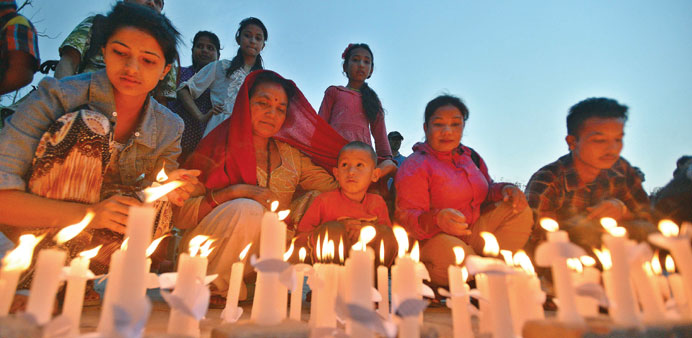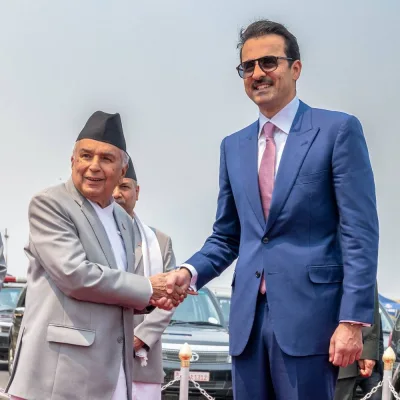Nepalese residents and others participate in a candlelight memorial for the victims of the April 25 earthquake in Kathmandu yesterday, as the country marks one month since a deadly earthquake struck the Himalayan nation.
AFP
Kathmandu
Hundreds of Nepalis gathered yesterday at the rubble of a 19th-century tower in Kathmandu to mark one month since a devastating earthquake killed more than 8,600 people in the
Himalayan nation.
The quake, which was followed by a second major tremor on May 12, brought down buildings across the country including historic temples, monuments and the much-loved Dharahara tower as tourists and locals climbed its more than 200 steps.
After the national anthem was played on loudspeakers, crowds surrounded the collapsed tower and observed 56 seconds of silence at 11:56, the moment the 7.9-magnitude quake ripped through Nepal on April 25.
Nina Shrestha, a 23-year-old student carrying a small Nepali flag, said the nine-storey tower was “always the first thing” she looked for when flying into Kathmandu.
“Its collapse signifies the devastation our country has suffered,” she said.
The 50.5m (165ft) high attraction — which contained a spiral staircase and offered visitors panoramic views of the capital — was reduced to just its base when the quake struck.
Ram Chandra Shrestha, who spent 12 years tending the garden in the tower complex, said that “it is hard to look up and not see the tower, it sends a chill through my heart”.
Those attending the ceremony, organised by political party Bibeksheel Nepali, told of their despair not only of losing their homes but also their jobs, leaving them facing a bleak future.
Like thousands of others, 41-year-old Dil Maya Rai has been living in a tent since the massive quake.
“We can’t find a room to rent and the carpet factory where I worked also collapsed in the quake,” Rai said.
“I don’t know how we will get by,” he said.
The twin quakes destroyed nearly half a million houses and left thousands in desperate need of food, clean water and shelter, with experts warning that the opportunity to help victims is closing fast before monsoon rains arrive next month.
The World Food Programme announced plans to open up land and air routes to get more aid to far-flung mountain villages demolished by the quake, although no details were given.
“To open up some of the overland routes is gonna be incredibly difficult, it’s gonna be incredibly dangerous and it’s gonna be incredibly expensive,” WFP’s emergency coordinator Richard Ragan told reporters.
The United Nations has repeatedly called on international donors to ramp up their aid contributions, with only a fifth of its $423mn appeal trickling in so far.
Ragan also denied allegations in the Nepali press that villagers found the rice distributed by the organisation to be inedible.
“We did tests... and found that there was a high percentage of broken rice and we immediately began to replace it.
“The issue was not that it was inedible,” he said.



